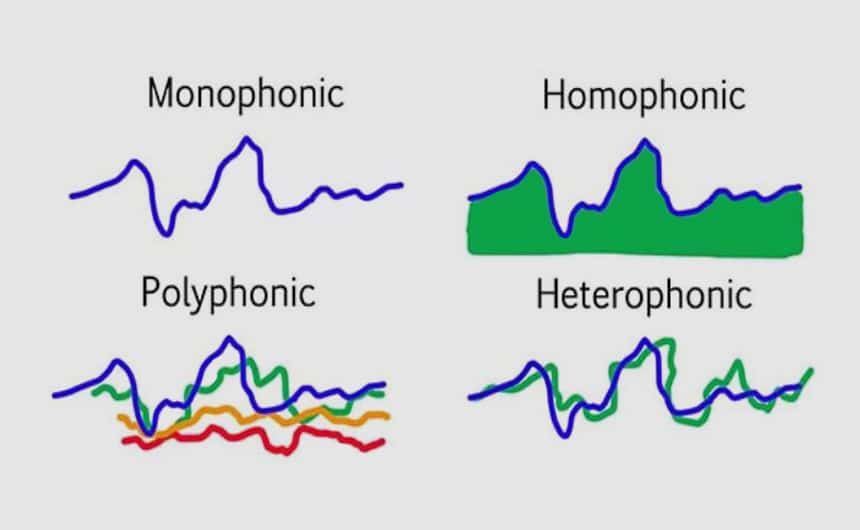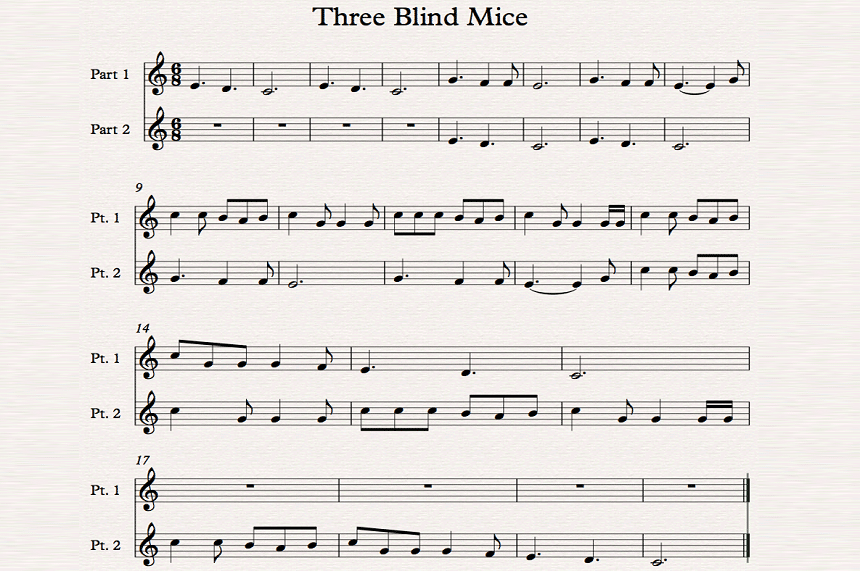You may have heard music junkies talk about the texture of music in the same way they would talk about the texture of a surface, food, or some fine art. If you’re wondering what in the world they are talking about, It’s time to explore texture in music definitively to get a sense of what it means, the types of texture in music, and how to identify them.
People describe texture in music using terms such as thick, thin, complex, or smooth. They generally use these terms in this sense to mean how the music sounds or what feelings it evokes. While that is correct to some extent, texture in music is more complicated than that.
The word “texture” itself would suggest a sense of touch or sight, but music texture is more about how it sounds. The trained musical ear can pick up the subtle elements that make up music and follow their interaction in the music, but the same problem of how to describe texture in music remains.

Music is organized or composed of many “blocks” or elements including pitch, melody, harmony, and rhythm. These elements are fused with tempo and timbre which are woven together, much like threads in fabric, to create distinct differences in music texture.
In other words, the texture of music refers to the way
different forms of sound
Trusted Source
THE ELEMENTS OF MUSIC
You are embarking on an adventure through musical time, and this journey will
be more pleasurable if you first become familiar with some basic musical concepts.
wmich.edu
are organized to create music. This leads to some informal descriptions of musical texture – for example, a “thick” texture might describe a piece of music having many instruments accompanying it, while a “thin” one could be Whitney Houston’s opening to her “I Will Always Love You.”
However, there are four standard terms used to define the four types of texture in music:
The four types of music texture represent the evolution of music in time from the simple, chant-like Gregorian pieces sung by monks to the complicated compositions we have today. They also represent the structure of music and how each of the parts contribute to the overall sound of the music.
Derived from the Greek word “mono” for single or one, monophonic texture means music with just one melodic line with no harmony or counterpoint accompaniment. It is the simplest form of musical texture and the earliest form of musical evolution.
Point to Note: Counterpoint is when you have two or more independent melodies working simultaneously to create music, and it is a core part of Western music while being relatively rare in other cultures.
Examples of monophonic texture in music could be a person whistling or singing a tune, a crowd singing an anthem, or Bach’s “Cello Suite No. 1.” Whitney Houston’s intro to “I Will Always Love You” is a clear and well-known form of monophonic music texture.
Monophonic music is easily identified on sheet music because it has only one continuous line of flowing music, usually with no accompaniment. Every piece of music has some form of monophonic sections in it, although it is rare to hear entire songs or compositions with only a single melodic line.
Being the simplest form of texture in music, monophonic music is the oldest kind of music. From folk songs to ancient Catholic chants, it forms the foundation of all music today.
A unique property of monophonic music is how easily it can move emotion. The simplistic style tends to connect with most people at a primitive level, rousing deep emotions and memories. Just listen to any of Bach’s Cello Suites or Debussy’s Syrinx for the solo flute:
The next evolution of music texture is polyphony, which refers to music with two or more simultaneous melodic lines. The translation from Greek of the word “polyphonic” literally means “many sounds,” which are then combined to form the overall sound.
Western music is a clear example of polyphony with its use of counterpoint, creating consonance and dissonance in the way the various melodic lines interact. In other words, melodic lines are created to complement each other. One example of this is when you have instruments or backup singers as accompaniments.
When listening to music with a polyphonic texture, you can pick up distinct melodic lines and follow them individually through the music yet still identify their harmonic relationship.
Famous examples of polyphonic texture are pieces of orchestral compositions such as Bach’s “Invention in D-Minor”and his “Fugue No. 17 in A-Flat Major.” Polyphony also characterizes the rich masterpieces of the Baroque and Renaissance period.
Knowledge of how polyphony works is an essential part of being able to play as part of an orchestra. That’s why we have this definitive guide on how to become a concert pianist if you want to learn more about it.
Homophonic texture in music refers to music with a single prominent melody supported by one or more less prominent one. You can think of homophonic texture as a kind of polyphony where one of the melodies is the major one while the rest add harmonic support.
All the melodies in a homophonic texture match the same vocal line, so it all sounds the same. Most hymns, patriotic songs, and Christmas Carols follow this musical texture, but Western music tends to defy this rule due to its use of counterpoint.
The various types of violin are especially adept at weaving into homophonic music, which is why you can often find 20 or more of them in large orchestras where they help to define the melody. The first violins carry the main melody, while the second ones will offer support and so on.
In general, homophonic texture favors music where you have one solo singer, rapper, or solo instrumentalists with accompaniment, or when you have several vocalists singing in harmony. When teaching about a complex element such as polyphony, it is often useful to have music posters such as these sound texture charts to help in explaining.
Heterophonic texture is where the same melody is varied by different vocals or instruments while the original is being played. This simultaneous variation of the the same melody leads to it being considered a type of monophony, even though the word “hetero” generally means “different.”
The difference in heterophonic musical texture arises in the fact that different instruments or vocalists will be singing the same melody. You can think of it as a blend of different monophonics where there is only one basic melody, with the others being elaborations or embellishments.
In this sense, heterophonic texture can also be thought to encroach on polyphony, although it is now regarded as its own category. Heterophony is not widespread in Western music, but it is common in folk music from the Irish, Chinese, and even in the USA.
The four major types of music texture explored above are the most common terms used to describe texture as an element of music. However, there are other terms not included either because they are not distinct categories in themselves, or because they are rare.
As the name suggests (homo = same), homorhythmic texture occurs when all parts of the melody and harmonious accompaniments have the exact same rhythm. It is also referred to as block chord texture, and is technically a subcategory of homophonic texture.
Examples of homorhythmic texture samples in music are mainly found in choral music and hymns, but Handel’s “Hallelujah Chorus” is a classical example. Contemporary examples include the openings of “Some Nights” by Fun and “Bohemian Rhapsody” by Queen.
Homorhythmic texture is also called block cord texture because the chords often appear as solid chords in the sheet music. Any other type of homophony lacking this characteristic is melody-dominated texture, where the harmony doesn’t exactly line up with the melody.
A solo singer playing an instrument is one example of melody-dominated texture, and this is actually one of the most common forms for solo performers. If you’d like to know how to accompany your singing with the beautiful sounds of the piano, here’s a power guide on how to learn piano fast.
To get a sense of just how beautiful this kind of texture is, Adele’s “Someone Like You” is a prime example of melody-dominated texture where the piano plays a slightly different rhythm from the singing.

Imitation in music theory is defined as the repetition of a melody’s polyphonic texture in a different voice, but shortly after its first appearance. The imitative line is equally prominent to the first and similar in shape and sound, creating what is called imitative polyphony.
Imitation is a device used extensively in choral music and contemporary pop music, especially when the backing singers repeat after the lead vocalist. Most rounds such as Three Blind Mice are also perfect examples of imitation.
We have already come across counterpoint as a form of polyphony in Western Music. It is not a category of musical texture in itself, but it is an important part of texture as an element. Counterpoint defines the relationship between two or more musical lines or voices which are independent in terms of rhythm, yet fully interdependent in harmony.
Counterpoint is clearly seen in Bach’s “invention 8 in F Major” in which you can clearly define a main melody and the slightly different voices as accompaniments. Counterpoint can be found in music in any category including polyphony, homophony, and heterophony.
There are many informal descriptions of texture in music, but only the four main ones described here are accepted as standard definitions. Texture in music refers to the use of the various elements of music such as rhythm, melody, harmony, and form to create complex compositions with a distinct sound and flavor.
The keen student of music shouldn’t be satisfied with this cursory introduction, though, because there is a lot more about texture in music that isn’t covered here. John David White has authored an excellent book on the same titled “Theories of Musical Texture.”
The book focuses on the theory of musical texture especially in Western music and its history, making it a must-read. At the end of the day, remember that texture is key in creating and playing quality music, whether alone or as part of a group.